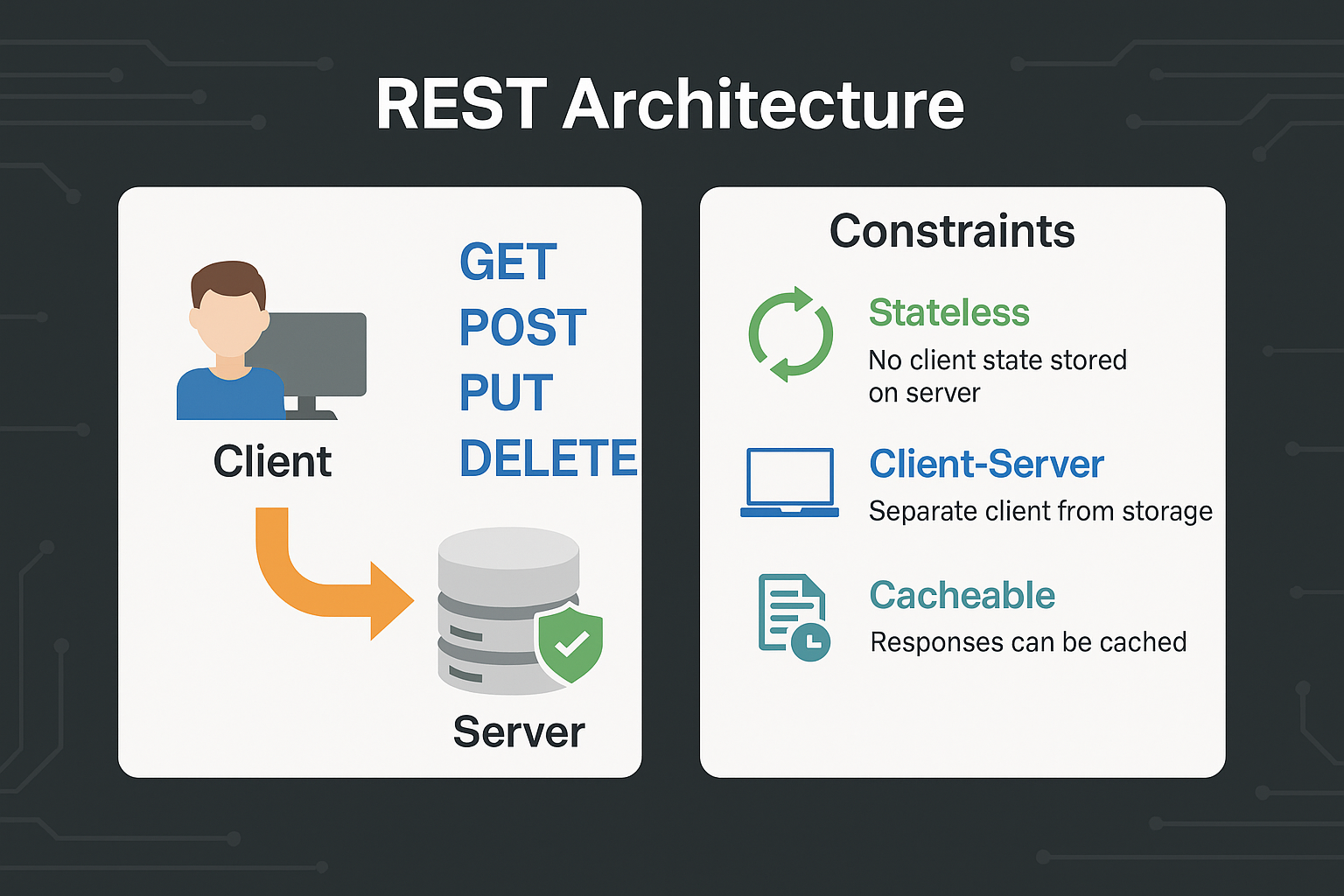REST Architecture
The Representational State Transfer (REST) architecture is one of the most widely used styles for designing networked applications. REST provides a set of architectural constraints that enable scalable, reliable, and stateless communication between clients and servers. Today, REST underpins most web APIs, from social media platforms to enterprise-grade distributed systems.
What is REST?
REST is an architectural style for building distributed systems, introduced by Roy Fielding in his 2000 doctoral dissertation.
The key idea is to treat everything as a resource (e.g., a user, a document, an order), which can be uniquely identified by a URI and manipulated using a uniform interface (typically HTTP methods like GET, POST, PUT, and DELETE).

Core Principles of REST
REST is guided by six core architectural constraints:
1. Client-Server
- Separation of concerns: The client (frontend) is decoupled from the server (backend).
- Example: A React frontend calling a Node.js REST API.
2. Statelessness
- Each request from the client contains all necessary information (no stored session on the server).
- Example: Each API call includes an Authorization token.
3. Cacheability
- Responses must explicitly indicate whether they are cacheable.
- Example: HTTP headers (
Cache-Control,ETag) allow browsers to reuse responses.
4. Uniform Interface
- A standard, consistent way of interacting with resources.
- Example:
GET /users/1→ Fetch user with ID=1.POST /users→ Create a new user.
5. Layered System
- Clients don’t know if they’re connected directly to the server or through intermediaries (e.g., load balancers, proxies).
- Example: Using CDNs in front of REST APIs.
6. Code on Demand (Optional)
- Servers can return executable code (like JavaScript) to clients.
- Rarely used, but still part of REST’s definition.
RESTful Resource Representation
- Resources: Anything identifiable (users, products, orders).
- URIs: Each resource has a unique URI.
- Example:
/api/v1/products/42
- Example:
- Representations: Resources can be represented in formats like JSON, XML, or HTML.
Example: JSON Response
{
"id": 42,
"name": "Wireless Mouse",
"price": 19.99,
"in_stock": true
}RESTful HTTP Methods
REST leverages HTTP methods to perform actions on resources:
| Method | Description | Example Endpoint |
|---|---|---|
| GET | Retrieve resource(s) | GET /users/1 |
| POST | Create a new resource | POST /users |
| PUT | Update a resource (replace fully) | PUT /users/1 |
| PATCH | Update a resource (partial) | PATCH /users/1 |
| DELETE | Remove a resource | DELETE /users/1 |
Example REST API Workflow
Imagine an e-commerce system with resources like users, products, and orders.
Create User:
POST /users→ Creates a new user.List Products:
GET /products→ Returns all products.Place Order:
POST /orders→ Places a new order.Update Order:
PUT /orders/123→ Updates order #123.Cancel Order:
DELETE /orders/123→ Deletes order #123.
Benefits of REST
- Simplicity: Easy to understand and widely adopted.
- Scalability: Statelessness and cacheability make it scalable.
- Flexibility: Supports multiple representations (JSON, XML).
- Interoperability: Works across different platforms and languages.
- Performance: Caching reduces repeated server load.
Challenges of REST
- Over-fetching & Under-fetching: Clients may get too much or too little data.
- Statelessness Overhead: Each request must include all context.
- Complex Transactions: REST struggles with multi-step, atomic operations.
- Versioning: Managing evolving APIs can be tricky (
/api/v1/...vs/api/v2/...).
REST vs Alternatives
| Feature | REST | GraphQL | gRPC |
|---|---|---|---|
| Style | Resource-based | Query-based | RPC-based |
| Data Fetching | Fixed endpoints | Flexible queries | Contracts (Protobuf) |
| Performance | Moderate | Efficient for clients | High (binary) |
| Use Case | General APIs | Mobile apps, dashboards | Microservices |
Security Considerations
- Authentication: Use OAuth2 or JWT for stateless authentication.
- Rate Limiting: Prevent abuse with throttling.
- HTTPS: Always encrypt requests/responses.
- Input Validation: Prevent SQL injection, XSS, etc.
Real-World Context
- Interviews: Commonly asked in system design rounds — “Design a REST API for X.”
- Industry Use: REST APIs power Google Maps, Twitter, GitHub, and countless services.
- Best Practices:
- Use plural nouns for resources (
/usersnot/getUser). - Provide meaningful HTTP status codes (e.g.,
200 OK,404 Not Found). - Document APIs with OpenAPI/Swagger.
- Use plural nouns for resources (
Further Reading
- RESTful Web APIs by Leonard Richardson
- Roy Fielding’s Dissertation: Architectural Styles and the Design of Network-based Software Architectures
- Swagger/OpenAPI Documentation